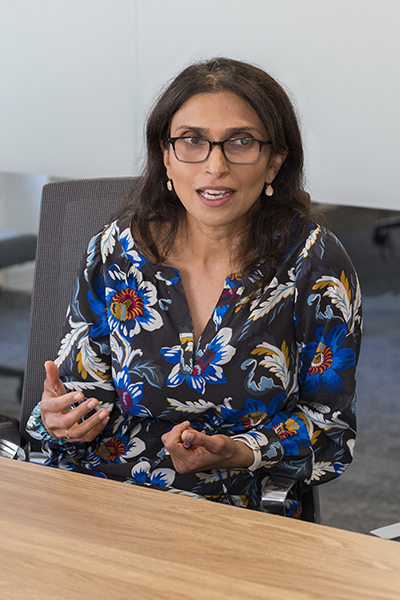Which asset classes are experiencing the financial impacts of physical climate risk most acutely?
Marina Severinovsky: Clearly, there are regions and sectors that are more exposed than others. For example, we carried out some research with Cornell’s Global Labor Institute regarding the need to protect workers from extreme heat. In that analysis, we found that without addressing worker safety, a number of countries in the fashion supply chain risk were missing out on $65 billion in export earnings and a million new jobs. These are the types of nuances that are important when considering the financial impact of climate risk.
 “If we know there is a climate risk, but we can’t discern the scale or the time frame, then it’s undefined”
“If we know there is a climate risk, but we can’t discern the scale or the time frame, then it’s undefined”
Bhavika Vyas,
StepStone Group
I would add that in addition to physical damage, you need to consider issues relating to loss of service, supply chain disruption, labour productivity losses, product recall and redesign, trade disruption and even inflation when thinking about the financial impacts of climate risk. All these things can elevate volatility in listed assets, which represent most of our AUM, together with higher borrowing costs for companies that are at risk. Having said all that, climate risk also heralds investment opportunities, of course – particularly relating to adaptation.
How can you measure physical climate risk in a private credit portfolio, in particular?
Jeff Cohen: The simple answer is, it’s not easy. That is partly because private credit investors have limited access to information, particularly in certain sponsor-backed deals and depending on the credit investor’s role in the financing. A private credit investor’s ability to connect with company management may also be limited. It’s debatable whether detailed climate information for all the different sites across a company and its suppliers is going to be at the top of your priority list relative to other information that you want to request at the time of issuance.
As far as how financially material physical climate risk may be, it depends on the time frame in which that risk is likely to mature. For us, the emphasis is on understanding acute risk because our investment horizon is not as long as it may be for private equity investors. It can be hard to get a full picture, but that is certainly something we consider in our underwriting in conjunction with all other risks.
Is access to information more readily available for other areas of the investment universe?
Nishesh Kumar: In the context of public markets investing, the short answer is no, we don’t have the information we require, and not for want of trying. Mitigation is one thing. There are metrics in place around Scope 1, 2 and 3 emissions. But if you are looking at a public company, with many different assets, it can be very challenging to determine what should be reported from an adaptation perspective. Should it be dollars spent, or miles of cable taken underground, or percentage of vegetation removed? There are just so many different potential metrics depending on the asset and its situation, that things can quickly get very complex.
I would add that, even armed with all this information, experiences with Hurricanes Katrina and Rita, for example, have taught us that a lot of this is just sheer dumb luck. You might own the one asset left standing after an extreme weather event or you could own the asset over the street that is wiped out. In some cases, even where assets have been left standing, those that run those operations haven’t been able to make it into their offices. In other words, even if you do all your homework, there can be curveballs.
Marina Severinovsky: There has been a significant increase in the physical risk data that has become available in recent years, but there are still challenges, certainly. Our private markets business, Schroders Capital, has spent the past 18 months looking at geospatial modelling for real assets, but we still haven’t found the perfect fit. There are companies out there that are doing modelling for buildings, but there don’t seem to be specific damage curve models for different infrastructure asset types. We need to be able to add asset-specific features in order to quantify risks for specific asset types and also be able to test any mitigation action that could potentially be taken to lower those risks.
On the public markets side, we use MSCI climate Value-at-Risk tools, but here again we find that data to be insufficient. So, I do think we need to see higher-quality, asset-specific location data that can be verified and published by the companies themselves, and then integrated into forward-looking climate scenario modelling.
A lot of the reporting on climate scenarios that we have seen focuses on time horizons out to 2050. We need to understand what the implications of specific climate events might be in a more immediate context, which is why we are actually trying to narrow models down to specific asset locations and shorter time periods.
Amanda Feldman: We find that data is relatively easy to access across all asset classes, so long as we ask the right questions upfront. We encourage fund managers to share the information they think is material to their investment strategy, while also following up on other information that is important to us. It is vital to set expectations at the outset.
Colin Etnire: As a buyout firm, we have a different level of access to information when compared to Jeff on the credit side, or when compared to a public markets investor, for example. I think buyout firms are uniquely privileged when it comes to the level of access and level of control that they have over the asset.
 “A lot of this is just sheer dumb luck – even if you do all your homework, there can be curveballs”
“A lot of this is just sheer dumb luck – even if you do all your homework, there can be curveballs”
Nishesh Kumar,
JPMorgan
Furthermore, over the almost 10 years that I have been doing this, the cost of getting decision-useful data around climate risk has come down substantially. That decision-useful piece is important. Studies of a whole industry or a whole country’s exposure are not that useful to us as managers, owners and operators of specific companies. We need to know precisely where in a valley a factory is located and how exposed that location is to flood risk, for example. That information now exists and is accessible.
I would, however, echo Jeff in saying that we place a greater emphasis on acute risk than chronic risk. Physical climate risk is particularly important for businesses that have a handful of crucial assets, such as factory sites. If one of three factories is affected by flooding, that can have a huge financial impact, whereas if you have 1,600 sites, the impact of one or two being flooded won’t be nearly as significant.
How do you discern the relevant time horizon for an acute climate event and how do you factor that into underwriting?
Bhavika Vyas: If we know there is a climate risk, but we can’t discern the scale or the time frame, then it’s undefined. Some investments we have to take off the table entirely. But there are others that fall within a time frame where there is something we can actually do to address those risks. There are decisions we can make in the management of the asset or in portfolio construction that mean we can still put together a workable investment case.
Colin Etnire: We have a three- to five-year holding period in theory, which is a small window when it comes to the likelihood of acute climate risks.
But what about future buyers? Is the exit itself not compromised by not assessing physical climate risk on a longer-term basis?
Colin Etnire: We have a five-year target holding period but usually underwrite to 10 because we are thinking about the next owner. Potentially, we could lengthen that to 15 years, but if flood risk is deemed to be a once-in-a-100-year event, for example, we are still talking about a very short time horizon.
